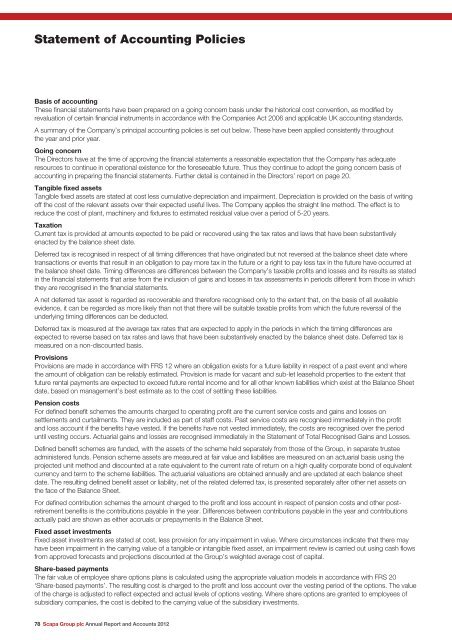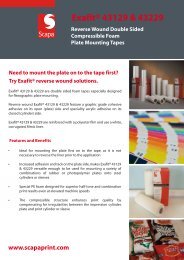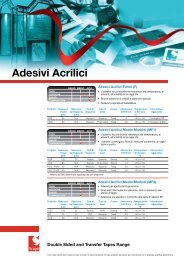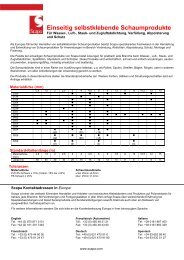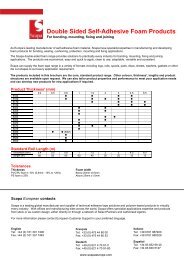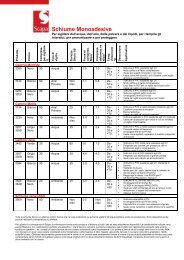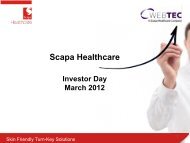Annual Report and Accounts 2012 - Scapa
Annual Report and Accounts 2012 - Scapa
Annual Report and Accounts 2012 - Scapa
You also want an ePaper? Increase the reach of your titles
YUMPU automatically turns print PDFs into web optimized ePapers that Google loves.
Statement of Accounting Policies<br />
Basis of accounting<br />
These financial statements have been prepared on a going concern basis under the historical cost convention, as modified by<br />
revaluation of certain financial instruments in accordance with the Companies Act 2006 <strong>and</strong> applicable UK accounting st<strong>and</strong>ards.<br />
A summary of the Company’s principal accounting policies is set out below. These have been applied consistently throughout<br />
the year <strong>and</strong> prior year.<br />
Going concern<br />
The Directors have at the time of approving the financial statements a reasonable expectation that the Company has adequate<br />
resources to continue in operational existence for the foreseeable future. Thus they continue to adopt the going concern basis of<br />
accounting in preparing the financial statements. Further detail is contained in the Directors’ report on page 20.<br />
Tangible fixed assets<br />
Tangible fixed assets are stated at cost less cumulative depreciation <strong>and</strong> impairment. Depreciation is provided on the basis of writing<br />
off the cost of the relevant assets over their expected useful lives. The Company applies the straight line method. The effect is to<br />
reduce the cost of plant, machinery <strong>and</strong> fixtures to estimated residual value over a period of 5-20 years.<br />
Taxation<br />
Current tax is provided at amounts expected to be paid or recovered using the tax rates <strong>and</strong> laws that have been substantively<br />
enacted by the balance sheet date.<br />
Deferred tax is recognised in respect of all timing differences that have originated but not reversed at the balance sheet date where<br />
transactions or events that result in an obligation to pay more tax in the future or a right to pay less tax in the future have occurred at<br />
the balance sheet date. Timing differences are differences between the Company’s taxable profits <strong>and</strong> losses <strong>and</strong> its results as stated<br />
in the financial statements that arise from the inclusion of gains <strong>and</strong> losses in tax assessments in periods different from those in which<br />
they are recognised in the financial statements.<br />
A net deferred tax asset is regarded as recoverable <strong>and</strong> therefore recognised only to the extent that, on the basis of all available<br />
evidence, it can be regarded as more likely than not that there will be suitable taxable profits from which the future reversal of the<br />
underlying timing differences can be deducted.<br />
Deferred tax is measured at the average tax rates that are expected to apply in the periods in which the timing differences are<br />
expected to reverse based on tax rates <strong>and</strong> laws that have been substantively enacted by the balance sheet date. Deferred tax is<br />
measured on a non-discounted basis.<br />
Provisions<br />
Provisions are made in accordance with FRS 12 where an obligation exists for a future liability in respect of a past event <strong>and</strong> where<br />
the amount of obligation can be reliably estimated. Provision is made for vacant <strong>and</strong> sub-let leasehold properties to the extent that<br />
future rental payments are expected to exceed future rental income <strong>and</strong> for all other known liabilities which exist at the Balance Sheet<br />
date, based on management’s best estimate as to the cost of settling these liabilities.<br />
Pension costs<br />
For defined benefit schemes the amounts charged to operating profit are the current service costs <strong>and</strong> gains <strong>and</strong> losses on<br />
settlements <strong>and</strong> curtailments. They are included as part of staff costs. Past service costs are recognised immediately in the profit<br />
<strong>and</strong> loss account if the benefits have vested. If the benefits have not vested immediately, the costs are recognised over the period<br />
until vesting occurs. Actuarial gains <strong>and</strong> losses are recognised immediately in the Statement of Total Recognised Gains <strong>and</strong> Losses.<br />
Defined benefit schemes are funded, with the assets of the scheme held separately from those of the Group, in separate trustee<br />
administered funds. Pension scheme assets are measured at fair value <strong>and</strong> liabilities are measured on an actuarial basis using the<br />
projected unit method <strong>and</strong> discounted at a rate equivalent to the current rate of return on a high quality corporate bond of equivalent<br />
currency <strong>and</strong> term to the scheme liabilities. The actuarial valuations are obtained annually <strong>and</strong> are updated at each balance sheet<br />
date. The resulting defined benefit asset or liability, net of the related deferred tax, is presented separately after other net assets on<br />
the face of the Balance Sheet.<br />
For defined contribution schemes the amount charged to the profit <strong>and</strong> loss account in respect of pension costs <strong>and</strong> other postretirement<br />
benefits is the contributions payable in the year. Differences between contributions payable in the year <strong>and</strong> contributions<br />
actually paid are shown as either accruals or prepayments in the Balance Sheet.<br />
Fixed asset investments<br />
Fixed asset investments are stated at cost, less provision for any impairment in value. Where circumstances indicate that there may<br />
have been impairment in the carrying value of a tangible or intangible fixed asset, an impairment review is carried out using cash flows<br />
from approved forecasts <strong>and</strong> projections discounted at the Group’s weighted average cost of capital.<br />
Share-based payments<br />
The fair value of employee share options plans is calculated using the appropriate valuation models in accordance with FRS 20<br />
‘Share-based payments’. The resulting cost is charged to the profit <strong>and</strong> loss account over the vesting period of the options. The value<br />
of the charge is adjusted to reflect expected <strong>and</strong> actual levels of options vesting. Where share options are granted to employees of<br />
subsidiary companies, the cost is debited to the carrying value of the subsidiary investments.<br />
78 <strong>Scapa</strong> Group plc <strong>Annual</strong> <strong>Report</strong> <strong>and</strong> <strong>Accounts</strong> <strong>2012</strong>


